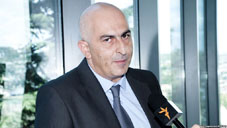
Sakdrisi Protection Commission demands punishment of officials
By Tea Mariamidze
Thursday, December 18
The Sakdrisi Protection Council, composed of NGOs, civil society representatives and ordinary people, is demanding the punishment of the head of the Cultural Heritage Agency of Georgia Nikoloz Antidze and all the officials who signed an “obscure” document regarding the excavation of Sakdrisi, which might be the oldest gold mine in the world.
“We will do our best to know the names of those officials who committed the crime against humanity,” the council stresses.
They admit that there was just a single document drafted through the financial support of RMG Gold, the company undertaking the mining work in Sakdrisi.
The activists interrupted a press-conference held by Antidze on December 16, demanding his resignation.
The Cultural Heritage Agency and the Ministry of Culture state that the decision regarding removing the status of cultural heritage was made by a special commission composed of competent people.
However, the activists stress that the document was not published and the people within the commission were not professionals.
The Cultural Heritage Agency stresses that they have already send the documents to the Ombudsman’s Office and the Georgian Young Lawyers’ Association (GYLA)
Head of GYLA Kakha Kozhoridze states that removing the status of cultural heritage requires quite a lot of time and carrying out mining activities in Sakrdisi raised many questions.
For 10 years Professor Thomas Stoellner, a leading specialist in mining archaeology from the University of Bochum, Germany, has been studying the archaeological record at Sakdrisi together with his Georgian colleagues.
"When we went to do the first survey we found hammer stones - typical mining tools - thousands of them," says Prof Stoellner, who believes that tunnels inside the hill date back 5,400 years.
"At once I realized the importance of the site. When we got the first value carbon dates, and they were around 3,000 BC, it was clear that this was an exciting find which had never occurred in pre-historic mining."


